Keeping Scenery Light
By Joseph Norris
Most of my recent construction has been on ‘portable’ layouts and dioramas. I always strive to keep them as lightweight as possible and keep my eyes open for ‘new’ techniques to facilitate this. Recently I tried an experiment that seems to show promise. While new to me, I’m sure that others have preceded me using this method. The sample module shown in this article was constructed in about 15 minutes, including photography time. While the photos lack detail in black and white, the completed scene is quite vivid and colorful.Using scrap materials at hand, I began with a piece of ¼ inch foam core board as the base and cut some random shapes of 1 inch bead board foam (very inexpensive, though messy to work with). I rounded the edges of the shapes. After ‘playing chess’ a bit, I glued them to the base with Aleene’s Clear Gel Tacky Glue (see Figure 1.)
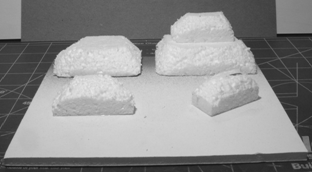
|
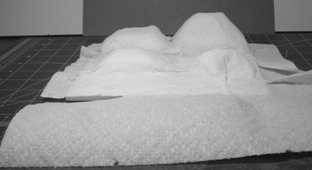
|
| Figure 1 | Figure 2 |
I then got a sheet of ordinary paper towel and draped it over the shapes to form reasonable contours in the scene, pressing it into the glue and molding it with my fingers until I was satisfied I had a workable surface.
At this point, it might be prudent to give the glue time to dry, but I kept right on going. I cut
away the excess paper towel with a razor blade and covered the entire scene with a heavy coat of
ordinary latex paint, in a basic ground color, using a soft bristle, 1 inch paint brush. I followed
this with the first layer of ground cover, which for me is finely ground dried leaves. I like to
use the leaves first because they provide a textured background for the subsequent layers which are
usually very fine particles. This ‘forest floor’ is held securely by the thick paint. Figure 3 shows
the module, trimmed and primed with latex, and the foreground has been covered with the crushed leaves.
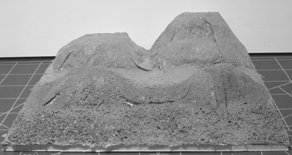 I allowed the module some drying time, at least an hour.
I allowed the module some drying time, at least an hour.
An advocate of multi-layer scenery, I added layers of ground dirt, in two colors, and a variety of grass colors. In the past I have used a diluted white glue to prepare the surface for these additional layers. More recently I have been experimenting with Elmer’s Craft Bond spray adhesive and have been very pleased with the results. It has the advantage of not soaking the paper towel structure and makes it a simple matter to cover the entire working area thoroughly and quickly. A few trees and some Woodland Scenics foam bushes and the module is beginning to look acceptable.
Figure 3
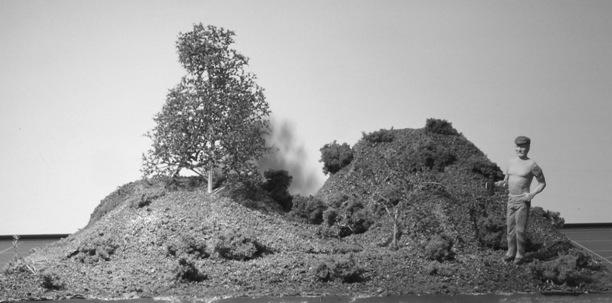
|
| Figure 4: Here we see the completed experiment with an O Scale figure |
This technique provides a reasonably firm shell that is extremely light weight. The shell will support trees in HO and smaller scales, though it may require some reinforcement for very large trees. While admittedly fragile, it would serve well in those areas of the layout that do not have to support heavy weights. It will support Hydrocal castings readily, and with some forethought in placing the underlying supports, could be used to surround even heavy structures. For additional strength, multiple coats of latex primer can be added. Of course, one is not limited to a single paper towel; they can be joined to cover any required area, similar to the use of plaster soaked cloth.
I like to make small modules of this kind to try new methods so that I am clear how to proceed when working on my layout. I invite you to give this very inexpensive and flexible scenery technique a try.
Steam returns to Spencer during Rail Days!
This weekend - April 26 & 27 from 9 a.m. - 5 p.m.
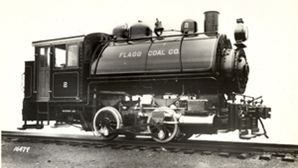 The restored Flagg Coal Co. No. 75 steam locomotive will be working at Spencer this weekend. It was in Bryson City
last summer during GSMR’s annual Rail Fest.
The restored Flagg Coal Co. No. 75 steam locomotive will be working at Spencer this weekend. It was in Bryson City
last summer during GSMR’s annual Rail Fest.It can often be found running at the Steam Railroading Institute in Michigan, where visitors can experience a bit of a bygone era in railroading. The locomotive also travels to other tourist and short line railroads across the country so more people can experience riding behind a steam locomotive. This engine, an 0-4-0 configuration locomotive, was built in 1930 by Vulcan Iron Works of Wilkes-Barre, Pa. A small, industrial-type locomotive, No. 75 was first purchased by the Flagg Coal Company in Pennsylvania, then sold in 1935 to the Solvay Process Quarry in New York, where it was used to push cart loads of rock.
